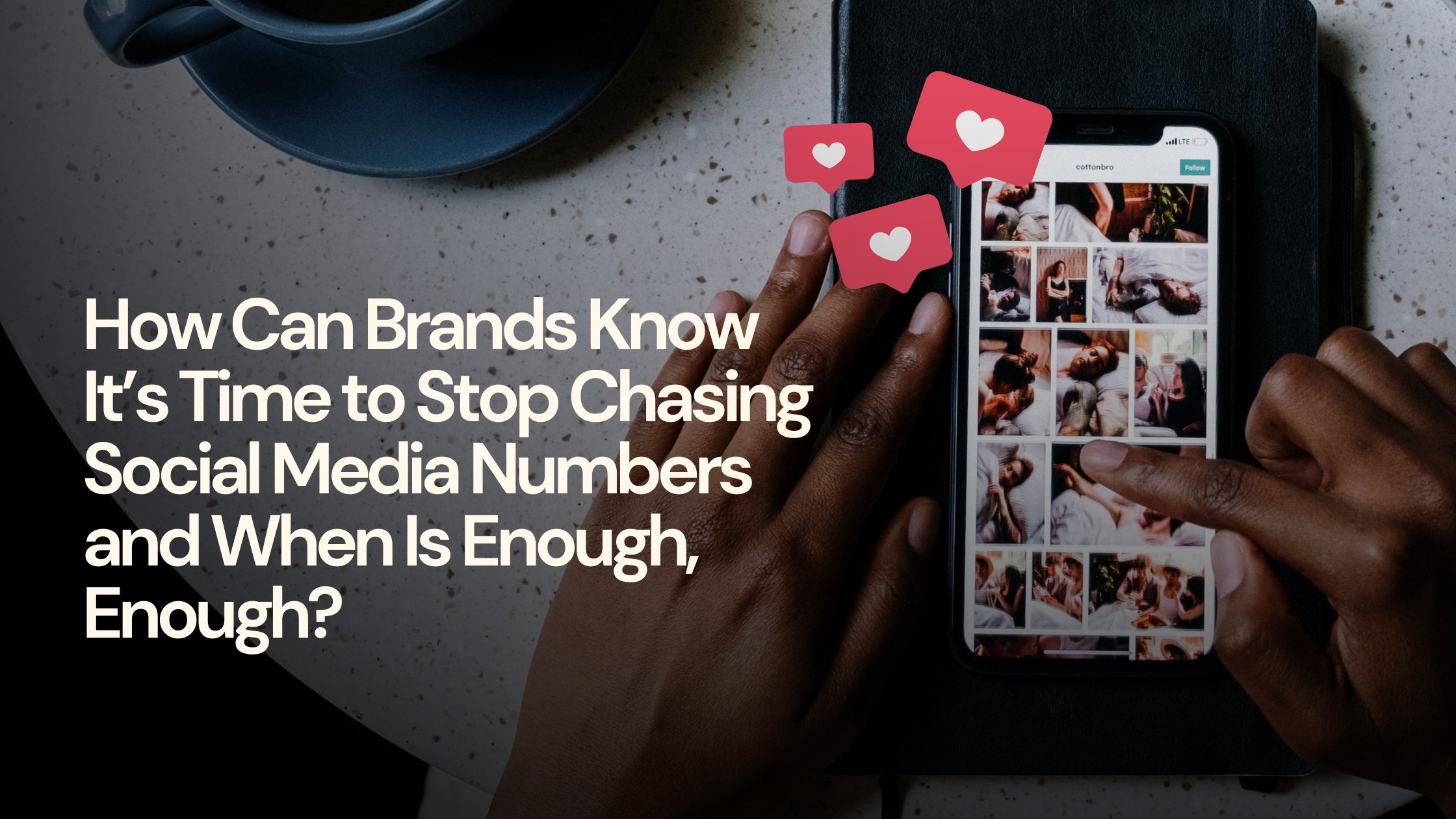
The Obsession with Metrics
Digital success often comes with a number attached – followers, likes, views, subscribers, shares. For creators, entrepreneurs, and even everyday users, these figures are usually treated equivalent to their worth and influence. Follower counts, impressions, engagement rates, click-throughs, these are the numbers that you would find in any digital performance report (we also include it for most of our clients), inform campaigns, and often help make strategic decisions. But as social platforms evolve, so does a critical question: How long should brands keep chasing social media growth before realizing that more isn’t always better?
For years, growth metrics have been equated with relevance. A large audience suggested authority, awareness, and influence. We once were rejected by a prospective candidate citing “our LinkedIn page doesn’t have enough followers”. However, recent research points to a growing fatigue among marketers and executives who recognize that scale without depth no longer guarantees impact.
A 2023 HubSpot State of Marketing Report revealed that while 67% of brands still prioritize follower growth, over half now cite engagement quality and brand trust as more reliable indicators of success. The race for numbers is giving way to a race for meaning.
A 2022 study published in Cyberpsychology, Behavior, and Social Networking found that individuals who frequently check social media metrics experience heightened anxiety and lower self-esteem and I feel that the same can be said for Brands. The dopamine-driven feedback loop, social “likes” triggering reward centers in the brain, can create an addictive cycle similar to gambling where you want to constantly check how many followers were gained or whether the latest post performed better than the one before or not.
The Illusion of Growth and the Hedonic Treadmill
Psychologically and strategically, the pursuit of ever-larger metrics mirrors what behavioral economists call the hedonic treadmill: once one target is achieved, another replaces it, often with diminishing satisfaction and escalating resource drain.
For brands, this plays out as constant content churn, increased ad spend, and short-term performance tactics that may boost visibility but dilute identity. A 2022 Deloitte Digital study found that 64% of marketers felt pressure to prioritize algorithm-driven growth at the expense of long-term brand equity.
When metrics become the mission, creativity narrows. The focus shifts from telling a brand story to feeding a platform. And while this may deliver incremental engagement, it rarely builds enduring loyalty. We had a client approach us 2 years back with a requirement of 100 posts a month for their Instagram page because someone had told them that 3 posts a day for every day will result in 10 times follower growth, we politely refused of course, but 2 years later, their numbers are plateaued and their engagement rates are extremely low for spamming Instagram with poor quality mass produced type of content.
When Numbers Stop Reflecting Meaning
There comes a tipping point when “more” starts to lessen brand value rather than enhance it. If you are a brand and would like to evaluate whether your social tipping point has reached or not, look for following:
- Engagement is high, but advocacy is low – A large audience without meaningful conversation or user-generated content often signals shallow connection, e.g. you have 1 million followers but manage to get 10 likes per post and 0-2 comments.
- Content decisions are data-driven, not brand-driven – When analytics dictate every post, brand voice risks becoming reactive instead of distinctive.
- ROI is flattening – According to Sprout Social’s 2024 Index, 58% of marketers say audience growth has reached a plateau in ROI effectiveness compared to initiatives focused on retention and loyalty.
- Employee and creator burnout rises – Behind every “brand account” are teams or partners facing constant production pressure, sometimes that can be a leading cause of creative fatigue and turnover in digital marketing roles. Probably the reason why you end up seeing the same content copied and shared by multiple handles.
Metrics are important, they help measure reach, impact, and audience engagement. But over time, they can distort purpose. When creators managing a brand start tailoring their content purely to algorithmic favor, creativity and authenticity suffer.
Redefining Success: From Reach to Resonance
If you want to be a futuristic brand, your digital brand strategy should think beyond the existing reach metrics. Instead of measuring success solely by audience size, you need to focus on resonance, how deeply a message connects, how long it stays relevant, and how authentically it aligns with brand purpose.
A Harvard Business Review analysis found that brands emphasizing community engagement, shared values, and storytelling authenticity experience stronger customer retention and lifetime value than those centered on growth metrics alone.
For example, Patagonia’s social presence is built on advocacy, not amplification. Nike’s campaigns prioritize identity and empowerment over frequency. These brands prove that influence grows stronger when driven by why, not how many.
Knowing When Enough Is Enough
Sustainable digital strategy is not about abandoning growth, it’s about conceptualizing growth, understanding the future and creating content around it. The healthiest brands establish a balance between quantitative and qualitative KPIs:
- Quantitative: reach, impressions, conversion rates.
- Qualitative: brand sentiment, community impact, content relevance.
When growth begins to compromise message integrity, brand cohesion, or internal well-being, it’s time to pause and recalibrate.
As McKinsey & Company noted in a 2024 report on digital maturity, “The most resilient brands are those that shift from a growth-at-all-costs mindset to one centered on purposeful connection.”
For brands, it isn’t about how many follow you. It’s about who believes in you, engages with you, and stays loyal beyond the infinite-mindless scroll. When your metrics align with meaning, that’s when enough truly becomes enough.